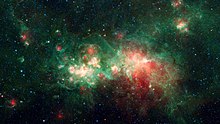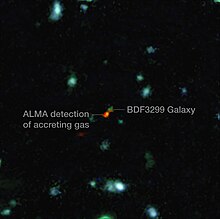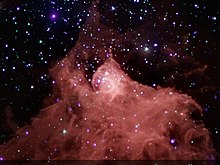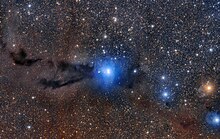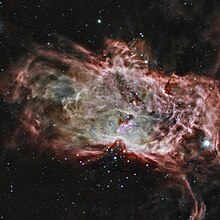The study of galaxy formation and evolution is concerned with the processes that formed a heterogeneous universe from a homogeneous beginning, the formation of the first galaxies, the way galaxies change over time, and the processes that have generated the variety of structures observed in nearby galaxies. Galaxy formation is hypothesized to occur from structure formation theories, as a result of tiny quantum fluctuations in the aftermath of the Big Bang. The simplest model in general agreement with observed phenomena is the Lambda-CDM model—that is, that clustering and merging allows galaxies to accumulate mass, determining both their shape and structure. Hydrodynamics simulation, which simulates both baryons and dark matter, is widely used to study galaxy formation and evolution.

A globular cluster is a spheroidal conglomeration of stars that is bound together by gravity, with a higher concentration of stars towards their centers. They can contain anywhere from tens of thousands to many millions of member stars, all orbiting in a stable, compact formation. Globular clusters are similar in form to dwarf spheroidal galaxies, and the distinction between the two is not always clear. Their name is derived from Latin globulus. Globular clusters are occasionally known simply as "globulars".

A molecular cloud, sometimes called a stellar nursery (if star formation is occurring within), is a type of interstellar cloud, the density and size of which permit absorption nebulae, the formation of molecules (most commonly molecular hydrogen, H2), and the formation of H II regions. This is in contrast to other areas of the interstellar medium that contain predominantly ionized gas.
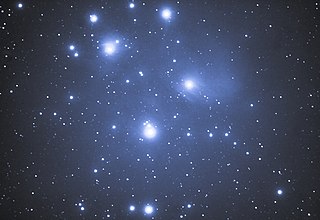
An open cluster is a type of star cluster made of tens to a few thousand stars that were formed from the same giant molecular cloud and have roughly the same age. More than 1,100 open clusters have been discovered within the Milky Way galaxy, and many more are thought to exist. They are loosely bound by mutual gravitational attraction and become disrupted by close encounters with other clusters and clouds of gas as they orbit the Galactic Center. This can result in a loss of cluster members through internal close encounters and a dispersion into the main body of the galaxy. Open clusters generally survive for a few hundred million years, with the most massive ones surviving for a few billion years. In contrast, the more massive globular clusters of stars exert a stronger gravitational attraction on their members, and can survive for longer. Open clusters have been found only in spiral and irregular galaxies, in which active star formation is occurring.

Stellar evolution is the process by which a star changes over the course of time. Depending on the mass of the star, its lifetime can range from a few million years for the most massive to trillions of years for the least massive, which is considerably longer than the current age of the universe. The table shows the lifetimes of stars as a function of their masses. All stars are formed from collapsing clouds of gas and dust, often called nebulae or molecular clouds. Over the course of millions of years, these protostars settle down into a state of equilibrium, becoming what is known as a main-sequence star.

Star clusters are large groups of stars held together by self-gravitation. Two main types of star clusters can be distinguished: globular clusters are tight groups of ten thousand to millions of old stars which are gravitationally bound, while open clusters are more loosely clustered groups of stars, generally containing fewer than a few hundred members, and are often very young. Open clusters become disrupted over time by the gravitational influence of giant molecular clouds as they move through the galaxy, but cluster members will continue to move in broadly the same direction through space even though they are no longer gravitationally bound; they are then known as a stellar association, sometimes also referred to as a moving group.

The nebular hypothesis is the most widely accepted model in the field of cosmogony to explain the formation and evolution of the Solar System. It suggests the Solar System is formed from gas and dust orbiting the Sun which clumped up together to form the planets. The theory was developed by Immanuel Kant and published in his Universal Natural History and Theory of the Heavens (1755) and then modified in 1796 by Pierre Laplace. Originally applied to the Solar System, the process of planetary system formation is now thought to be at work throughout the universe. The widely accepted modern variant of the nebular theory is the solar nebular disk model (SNDM) or solar nebular model. It offered explanations for a variety of properties of the Solar System, including the nearly circular and coplanar orbits of the planets, and their motion in the same direction as the Sun's rotation. Some elements of the original nebular theory are echoed in modern theories of planetary formation, but most elements have been superseded.

A supermassive black hole is the largest type of black hole, with its mass being on the order of hundreds of thousands, or millions to billions, of times the mass of the Sun (M☉). Black holes are a class of astronomical objects that have undergone gravitational collapse, leaving behind spheroidal regions of space from which nothing can escape, not even light. Observational evidence indicates that almost every large galaxy has a supermassive black hole at its center. For example, the Milky Way galaxy has a supermassive black hole at its center, corresponding to the radio source Sagittarius A*. Accretion of interstellar gas onto supermassive black holes is the process responsible for powering active galactic nuclei (AGNs) and quasars.

In 1944, Walter Baade categorized groups of stars within the Milky Way into stellar populations. In the abstract of the article by Baade, he recognizes that Jan Oort originally conceived this type of classification in 1926.

A protostar is a very young star that is still gathering mass from its parent molecular cloud. It is the earliest phase in the process of stellar evolution. For a low-mass star, it lasts about 500,000 years. The phase begins when a molecular cloud fragment first collapses under the force of self-gravity and an opaque, pressure-supported core forms inside the collapsing fragment. It ends when the infalling gas is depleted, leaving a pre-main-sequence star, which contracts to later become a main-sequence star at the onset of hydrogen fusion producing helium.

A protoplanetary disk is a rotating circumstellar disc of dense gas and dust surrounding a young newly formed star, a T Tauri star, or Herbig Ae/Be star. The protoplanetary disk may also be considered an accretion disk for the star itself, because gases or other material may be falling from the inner edge of the disk onto the surface of the star. This process should not be confused with the accretion process thought to build up the planets themselves. Externally illuminated photo-evaporating protoplanetary disks are called proplyds.

An intermediate-mass black hole (IMBH) is a class of black hole with mass in the range 102–105 solar masses: significantly more than stellar black holes but less than the 105–109 solar mass supermassive black holes. Several IMBH candidate objects have been discovered in the Milky Way galaxy and others nearby, based on indirect gas cloud velocity and accretion disk spectra observations of various evidentiary strength.

Herbig–Haro (HH) objects are bright patches of nebulosity associated with newborn stars. They are formed when narrow jets of partially ionised gas ejected by stars collide with nearby clouds of gas and dust at several hundred kilometres per second. Herbig–Haro objects are commonly found in star-forming regions, and several are often seen around a single star, aligned with its rotational axis. Most of them lie within about one parsec of the source, although some have been observed several parsecs away. HH objects are transient phenomena that last around a few tens of thousands of years. They can change visibly over timescales of a few years as they move rapidly away from their parent star into the gas clouds of interstellar space. Hubble Space Telescope observations have revealed the complex evolution of HH objects over the period of a few years, as parts of the nebula fade while others brighten as they collide with the clumpy material of the interstellar medium.

In astrophysics, accretion is the accumulation of particles into a massive object by gravitationally attracting more matter, typically gaseous matter, into an accretion disk. Most astronomical objects, such as galaxies, stars, and planets, are formed by accretion processes.

In astronomy, stellar kinematics is the observational study or measurement of the kinematics or motions of stars through space.
Scott Jay Kenyon is an American astrophysicist. His work has included advances in symbiotic and other types of interacting binary stars, the formation and evolution of stars, and the formation of planetary systems.

Westerhout 40 or W40 is a star-forming region in the Milky Way located in the constellation Serpens. In this region, interstellar gas forming a diffuse nebula surrounds a cluster of several hundred new-born stars. The distance to W40 is 436 ± 9 pc, making it one of the closest sites of formation of high-mass O-type and B-type stars. The ionizing radiation from the massive OB stars has created an H II region, which has an hour-glass morphology.
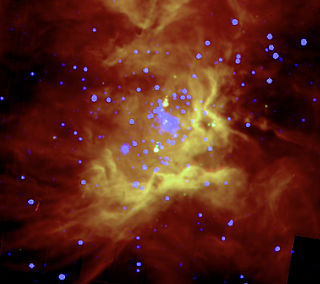
RCW 36 is an emission nebula containing an open cluster in the constellation Vela. This H II region is part of a larger-scale star-forming complex known as the Vela Molecular Ridge (VMR), a collection of molecular clouds in the Milky Way that contain multiple sites of ongoing star-formation activity. The VMR is made up of several distinct clouds, and RCW 36 is embedded in the VMR Cloud C.
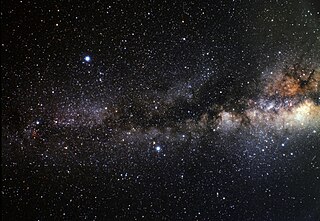
The Serpens–Aquila Rift (also known as the Aquila Rift) is a region of the sky in the constellations Aquila, Serpens Cauda, and eastern Ophiuchus containing dark interstellar clouds. The region forms part of the Great Rift, the nearby dark cloud of cosmic dust that obscures the middle of the galactic plane of the Milky Way, looking inwards and towards its other radial sectors. The clouds that form this structure are called "molecular clouds", constituting a phase of the interstellar medium which is cold and dense enough for molecules to form, particularly molecular hydrogen (H2). These clouds are opaque to light in the optical part of the spectrum due to the presence of interstellar dust grains mixed with the gaseous component of the clouds. Therefore, the clouds in the Serpens-Aquila Rift block light from background stars in the disk of the Galaxy, forming the dark rift. The complex is located in a direction towards the inner Galaxy, where molecular clouds are common, so it is possible that not all components of the rift are at the same distance and physically associated with each other.
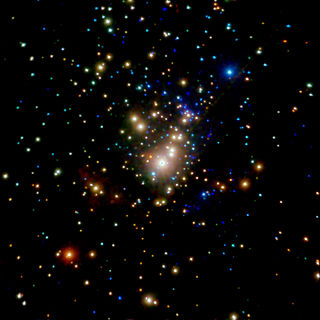
Embedded stellar clusters, or simply embedded clusters (EC), are open clusters that are still surrounded by their progenitor molecular cloud. They are often areas of active star formation, giving rise to stellar objects that have similar ages and compositions. Because of the dense material that surrounds the stars, they appear obscured in visible light but can be observed using other sections of the electromagnetic spectrum, such as the near-infrared and X-rays that can see through the cloud material. In the Milky Way Galaxy, embedded clusters can mostly be found within the Galactic disk or near the Galactic Center where most of the star-formation activity is happening.
